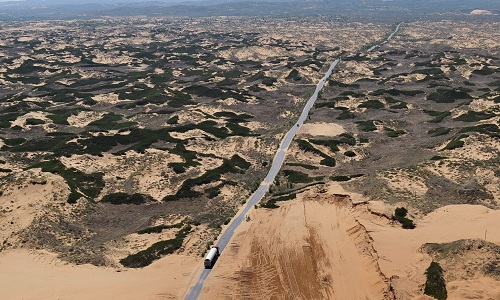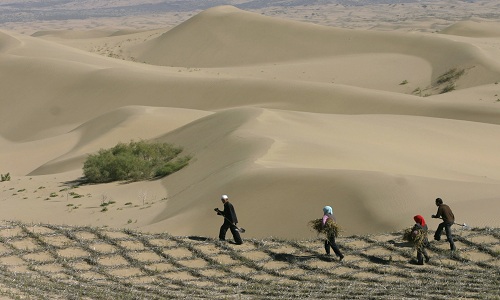China is rapidly turning into a desert
Desertification is devouring thousands of square kilometers of Chinese agricultural land each year, becoming an unprecedented challenge in this country.

A freighter is crossing deserted land in Hangshan District, Shaanxi Province in northwest China in 2011. Photo: Rooney Chen / Reuters.
According to Business Insider, the desertification rate in China increased during the second half of the last century. Although this trend has slowed down, the situation is still very serious. More than a quarter of China's land is degraded or transformed into a desert, due to cultivation and livestock, excessive use of water or climate change .
The Gobi desert alone invades 3,600 km2 of grassland each year. The Chinese government's Forestry Administration determines that desertification is the most important ecological issue in the country and that climate change makes the situation worse.
Desertification threatens the lives of about a third of China's population, especially those who live in the west and north, posing serious challenges to political and economic stability, causing damage. about 6.9 billion USD per year.
For a severe desertification area, losses amounted to 23.16% of annual GDP, according to research by Joey Jay Kassiola and Sujian Guo in the book China's Environmental Crisis published in 2010. In fact, About 400 million people are struggling to cope with the shortage of productive land, unstable climate conditions and serious water shortages when one third of the land area is eroded.
In addition, drought damages about 160,000 square kilometers of cultivated land each year, twice as much as the affected area in the 1950s.

Farmers are preparing to plant trees to stabilize the sand dunes at the desert edge of Mu Us in Linh Vu, the Lower Ninh Autonomous Region in northwest China in 2007. (Photo: Stringer / Reuters).
Caused by excessive breeding and farming, China began relocating millions of people from arid lands since 2005 under the " eco-migration" program.
However, deforestation makes the situation worse. According to Greenpeace, China only has 2% of primary forest, of which only 0.1% is fully protected. Despite efforts to reduce erosion, in 2011, the Chinese government had to acknowledge the desertification basically has not reversed.
In particular, increased dust and sandstorms pose geopolitical challenges. The Gobi Desert extends from China to Mongolia, the second largest source of dust in the world, just behind the Sahara Desert. The dust is an annual disaster in western China, flying over the Pacific Ocean and even further. Traces from the Chinese desert are also found in New Zealand and the French Alps, and gold dust makes the Korean and Japanese economies lose billions of dollars each year. This dust devastates animal and human health, associated with cardiovascular and respiratory disease in the last decade.

A sandstorm in Hoi Hai, the capital of the Inner Mongolia Autonomous Region in northeastern China in 2005. (Photo: Reuters).
Dust storms also release toxic pollutants, bacteria, viruses, pollen and fungi . When observing a dust storm in Korea, microbiologists discovered that bacteria in the air increased sharply.
Sand and sand storms became a major concern for governments. In 2005, the Asian Development Bank, the United Nations and regional countries developed a general plan to promote cooperation solutions.
More recently, the dust theme was put on the agenda at the 2015 tripartite summit with the participation of Korea, Japan and China. The Environment Minister from three countries meets each year and establishes a special working group to improve the ability to accurately forecast and develop vegetation restoration measures in areas in China.
- Project to turn desert into ... forest
- Amazon forests are at risk of turning into desert
- See China turn the desert dry into a carpet of over 7,000 hectares
- Arid desert 'risen' covered with roses
- China built a mysterious building in the desert
- Chinese desert covered in white snow in the weather -25 degrees Celsius
- The most exotic deserts in the world
- Green Walls will save China from sandstorms?
- Huge 'Ocean' under the dry desert in China
- Sandstorm threatens Chinese people
- The Amazon forest is in danger of turning into a desert
- The largest desert - desert in the world (1)
 Is the magnetic North Pole shift dangerous to humanity?
Is the magnetic North Pole shift dangerous to humanity? Washington legalizes the recycling of human bodies into fertilizer
Washington legalizes the recycling of human bodies into fertilizer Lightning stone - the mysterious guest
Lightning stone - the mysterious guest Stunned by the mysterious sunset, strange appearance
Stunned by the mysterious sunset, strange appearance